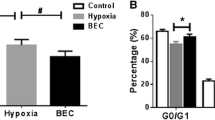Abstract
The endothelial glycocalyx has been proved to be a polysaccharide protein complex covering the surface of vascular endothelial cells, playing an important role in vascular permeability, blood flow shear stress induction, and prevention of endothelial cell adhesion. The pathogenesis of PAH includes pulmonary arterial endothelial cell dysfunction and pulmonary arterial smooth muscle cell (PASMCs) proliferation. Based on the physicochemical properties of endothelial glycocalyx involving pathogenesis of pulmonary hypertension. We hypothesized that the endothelial glycocalyx is involved in the development of pulmonary hypertension; pulmonary hypertension can be regulated by protecting the integrity of glycocalyx. Expression of glycocalyx markers including heparin sulfate proteoglycan (HSPG), hyaluronan (HA), and syndecan-1 (SDC-1) was detected in monocrotaline (MCT)-induced PAH in rats and these components were detected when the PAH rats were treated with heparin that protected the role of glycocalyx. Results showed that plasma levels of HSPG, HA, and SDC-1 were increased in MCT group when compared with control group. However, rats in treatment group showed reduced levels of HSPG, HA, and SDC-1. Expression of HSPG, HA, and SDC-1 in pulmonary arteries was also reduced in MCT group when compared with those in the control group. By contrast, expression of HSPG, HA, and SDC-1 in pulmonary arteries increased in treatment group. In conclusion, destruction of glycocalyx was involved in the development of pulmonary hypertension. Pulmonary hypertension can be regulated by protecting the integrity of glycocalyx.

Similar content being viewed by others
References
Gouverneur, M., B.V.D. Berg, M. Nieuwdorp, et al. 2006. Vasculoprotective properties of the endothelial glycocalyx: Effects of fluid shear stress. Journal of Internal Medicine 259: 393–400.
Reitsma, S., D.W. Slaaf, H. Vink, M.A.M.J. van Zandvoort, and M.G.A. oude Egbrink. 2007. The endothelial glycocalyx: Composition, functions, and visualization. Pflügers Archiv / European Journal of Physiology 454: 345–359.
Vanteeffelen, J.W., J. Brands, et al. 2007. Endothelial Glycocalyx: Sweet shield of blood vessels. Trends in Cardiovascular Medicine 17: 101–105.
Levick, J.R., and C.C. Michel. 2010. Microvascular fluid exchange and the revised Starling principle. Cardiovascular Research 87: 198–210.
Zeng, Y., M. Waters, A. Andrews, et al. 2013. Fluid shear stress induces the clustering of heparan sulfate viamobility of glypican-1 in lipid rafts. American Journal of Physiology. Heart and Circulatory Physiology 305: H811–H820.
Tarbell, J.M. 2010. Shear stress and the endothelial transport barrier. Cardiovascular Research 87: 320–330.
Lipowsky, H.H. 2012. The endothelial glycocalyx as a barrier to leukocyte adhesion and its mediation by extracellular proteases. Annals of Biomedical Engineering 40: 840–848.
Thourani, V.H., S.S. Brar, T.P. Kennedy, L.R. Thornton, J.A. Watts, R.S. Ronson, Z.Q. Zhao, A.L. Sturrock, J.R. Hoidal, and J. Vinten-Johansen. 2000. Nonanticoagulant heparin inhibits NF-kappaB activation and attenuates myocardial reperfusion injury. American Journal of Physiology. Heart and Circulatory Physiology 278: H2084–H2093.
Broekhuizen, L.N., H.L. Mooij, J.J. Kastelein, E.S.G. Stroes, H. Vink, and M. Nieuwdorp. 2009. Endothelial glycocalyx as potential diagnostic and therapeutic target in cardiovascular disease. Current Opinion in Lipidology 20: 57–62.
Kolářová H, Ambrůzová B, Svihálková Š L, et al. 2014.Modulation of endothelial glycocalyx structure under inflammatory conditions. Mediators of Inflammation 2014:694312, 1, 17.
Schmidt, E.P., Y. Yang, W.J. Janssen, A. Gandjeva, M.J. Perez, L. Barthel, R.L. Zemans, J.C. Bowman, D.E. Koyanagi, Z.X. Yunt, L.P. Smith, S.S. Cheng, K.H. Overdier, K.R. Thompson, M.W. Geraci, I.S. Douglas, D.B. Pearse, and R.M. Tuder. 2012. The pulmonary endothelial glycocalyx regulates neutrophil adhesion and lung injury during experimental sepsis. Nature Medicine 18: 1217–1223.
Koo, A., D. Nordsletten, R. Umeton, B. Yankama, S. Ayyadurai, G. García-Cardeña, and C.F. Dewey Jr. 2013. In silico modeling of shear-stress-induced nitric oxide production in endothelial cells through systems biology. Biophysical Journal 104: 2295–2306.
Ebong, E.E., S.V. Lopez-Quintero, V. Rizzo, D.C. Spray, and J.M. Tarbell. 2014. Shear-induced endothelial NOS activation and remodeling via heparan sulfate, glypican-1, and syndecan-1. Integrative Biology Quantitative Biosciences from Nano to Macro 6: 338–347.
Becker, B.F., D. Chappell, and M. Jacob. 2010. Endothelial glycocalyx and coronary vascular permeability: The fringe benefit. Basic Research in Cardiology 105: 687–701.
Schermuly, R.T., H.A. Ghofrani, M.R. Wilkins, and F. Grimminger. 2011. Mechanisms of disease: Pulmonary arterial hypertension. Nature Reviews Cardiology 8: 443–455.
Pietra, G.G., F. Capron, S. Stewart, O. Leone, M. Humbert, I.M. Robbins, L.M. Reid, and R.M. Tuder. 2004. Pathologic assessment of vasculopathies in pulmonary hypertension. Journal of the American College of Cardiology 43 (12-supp-s): 25S–32S.
Nelson, A., I. Berkestedt, A. Schmidtchen, L. Ljunggren, and M. Bodelsson. 2008. Increased levels of glycosaminoglycans during septic shock: Relation to mortality and the antibacterial actions of plasma. Shock 30: 623–627.
Donati, A., E. Damiani, R. Domizi, R. Romano, E. Adrario, P. Pelaia, C. Ince, and M. Singer. 2013. Alteration of the sublingual microvascular glycocalyx in critically ill patients. Microvascular Research 90: 86–89.
Sallisalmi, M., J. Tenhunen, R. Yang, et al. 2012. Vascular adhesion protein-1 and syndecan-1 in septic shock. Acta Anaesthesiologica Scandinavica 56: 316–322.
Steppan, J., S. Hofer, B. Funke, T. Brenner, M. Henrich, E. Martin, J. Weitz, U. Hofmann, and M.A. Weigand. 2011. Sepsis and major abdominal surgery lead to flaking of the endothelial glycocalix. Journal of Surgical Research 165: 136–141.
Johansson, P.I., J. Stensballe, L.S. Rasmussen, and S.R. Ostrowski. 2011. A high admission syndecan-1 level, a marker of endothelial glycocalyx degradation, is associated with inflammation, protein C depletion, fibrinolysis, and increased mortality in trauma patients. Annals of Surgery 254: 194–200.
Potter, D.R., J. Jiang, and E.R. Damiano. 2009. The recovery time course of the endothelial cell glycocalyx in vivo and its implications in vitro. Circulation Research 104: 1318–1325.
Author information
Authors and Affiliations
Corresponding author
Ethics declarations
Conflict of Interest
The authors declare that they have no conflicts of interest.
Additional information
Publisher’s Note
Springer Nature remains neutral with regard to jurisdictional claims in published maps and institutional affiliations.
Jing Guo and Zu-Cheng Yang contributed to the work equally and should be regarded as co-first authors
Rights and permissions
About this article
Cite this article
Guo, J., Yang, ZC. & Liu, Y. Attenuating Pulmonary Hypertension by Protecting the Integrity of Glycocalyx in Rats Model of Pulmonary Artery Hypertension. Inflammation 42, 1951–1956 (2019). https://doi.org/10.1007/s10753-019-01055-5
Published:
Issue Date:
DOI: https://doi.org/10.1007/s10753-019-01055-5




